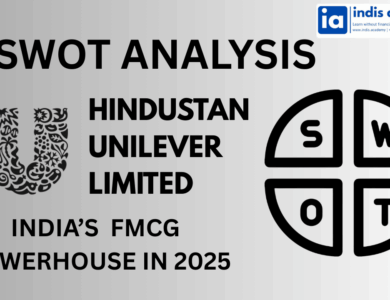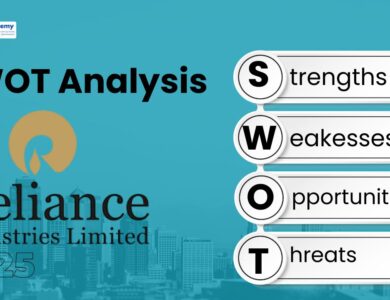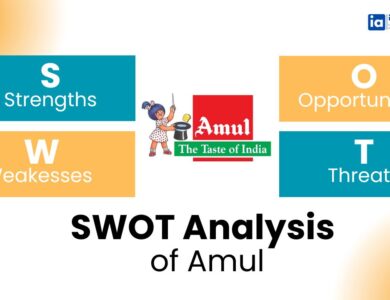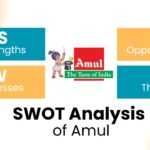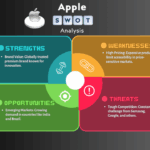SWOT Analysis of Nestlé: Strengths, Challenges and Global Strategy
Explore the SWOT analysis of Nestlé in 2025. Discover how the world’s largest food and beverage company is adapting to health trends, digital commerce, and sustainability goals while facing new market challenges.
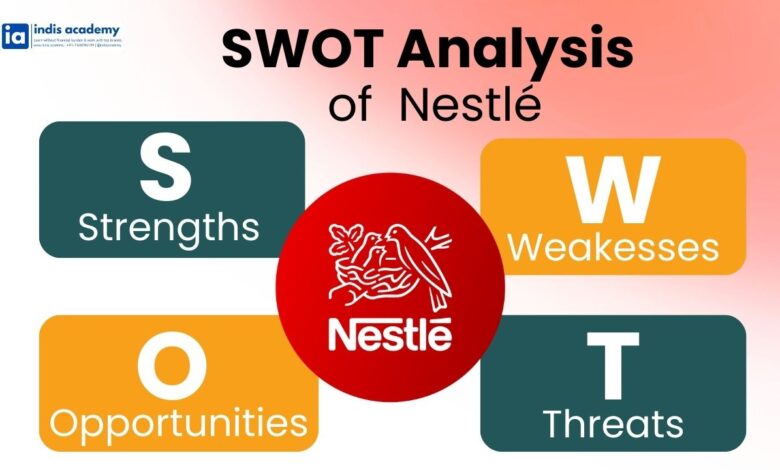
From Maggi noodles in Indian kitchens to Nescafé on office desks worldwide, Nestlé is a brand that needs no introduction. With a presence in over 180 countries and a legacy spanning more than 150 years, Nestlé is the world’s largest food and beverage company.
But 2025 brings new challenges.
Consumers are now demanding healthier ingredients, sustainable sourcing, and personalized nutrition. Governments are tightening rules around labeling, sugar, and plastic use. And digital-first brands are changing how food is bought, consumed, and even marketed.
That’s why a SWOT analysis of Nestlé is so important right now.
In this article, we’ll explore the Strengths, Weaknesses, Opportunities, and Threats of Nestlé in 2025—giving you a strategic snapshot of how this global FMCG giant is evolving to stay relevant in a rapidly changing world.
Learn AI & Digital Marketing,
Pay Fees After Placement
- ✅ Minimal Admission Fees
- ✅ No Loan or Income Sharing Agreement
- ✅ 100% Placement Support
- ✅ ISO & Govt Registered Certificate
- ✅ Practical 3+1 Months Duration
Get a free counseling call. We’ll guide you through learning, certification, and job placement.
Request a Free Call Back
Takes less than a minute.
Company Overview of Nestlé
Nestlé S.A., founded in 1866 in Switzerland, has grown into the world’s largest food and beverage company, operating in over 180 countries. Known for its deep focus on nutrition, health, and wellness, Nestlé’s portfolio includes more than 2,000 brands catering to every age group and lifestyle.
Key Business Highlights (2025):
- Global Headquarters: Vevey, Switzerland
- 2024–25 Global Revenue: Over CHF 95 billion (~₹9.1 lakh crore)
- Employees: 275,000+ globally
- Market Presence: Asia, Europe, Americas, Middle East, Africa
- Indian Entity: Nestlé India (publicly listed, ₹20,000+ crore revenue in FY25)
Popular Global Brands:
- Beverages: Nescafé, Milo
- Instant Food: Maggi, Hot Pockets
- Dairy & Nutrition: Lactogen, Cerelac, Nestlé Milk
- Snacks & Confectionery: KitKat, Milkybar
- Health & Wellness: Boost, Garden of Life, Vital Proteins
- Pet Food: Purina, Pro Plan
Nestlé’s future vision centers around “Good Food, Good Life”, aiming to balance profit with purpose—through cleaner nutrition, sustainability, and digital innovation.
What is a SWOT Analysis?
A SWOT analysis is a simple, yet powerful strategic tool used to evaluate a company’s current position in the market by examining four key areas:
- Strengths – Internal capabilities that give the company an edge
- Weaknesses – Internal limitations that may affect growth
- Opportunities – External trends the company can leverage
- Threats – External risks that could disrupt progress
For a legacy brand like Nestlé, conducting a SWOT analysis in 2025 is especially important.
As the food industry undergoes massive shifts in consumer preference, sustainability standards, and digital commerce, Nestlé must adapt quickly to stay relevant—without compromising the trust it has built over a century.
Let’s now explore what gives Nestlé its global leadership—and what could challenge it moving forward.
Also Read:
- SWOT Analysis of Reliance Industries (2025): Strategy, Strengths and Growth Outlook
- SWOT Analysis of Amul: India’s Dairy Giant & Cooperative Revolution
- SWOT Analysis of Britannia: How the Biscuit Giant Stays Ahead in India’s FMCG Market
- SWOT Analysis of Coca-Cola: Inside the Strategy of the Global Beverage Leader
- SWOT Analysis of Cadbury: Strengths, Weaknesses, Opportunities & Threats
Strengths of Nestlé
Nestlé’s success isn’t just built on brand recognition—it’s built on trust, innovation, global reach, and a finely tuned ability to meet consumer needs across cultures and continents.
Let’s explore what gives Nestlé its competitive edge in 2025:
1. Unmatched Global Brand Portfolio
With over 2,000 brands spanning beverages, nutrition, snacks, dairy, baby food, and pet care, Nestlé caters to virtually every life stage and demographic. Flagships like Nescafé, Maggi, KitKat, Lactogen, and Purina are global leaders in their segments.
2. Extensive Distribution & Market Penetration
Nestlé operates in over 180 countries, supported by a deep supply chain network and localized operations. Its ability to adapt products to regional tastes—like Masala Maggi in India or Milo in Southeast Asia—helps it maintain loyalty at a mass scale.
3. Strong R&D and Innovation Capabilities
With 24 R&D centers worldwide and a focus on nutrition science, sustainable packaging, and food tech, Nestlé invests heavily in product innovation, from plant-based protein to low-sugar reformulations.
4. Focus on Health, Wellness & Nutrition
Nestlé has repositioned itself from a processed food giant to a health-first nutrition brand, aligning with rising consumer interest in immune-boosting, clean-label, and functional food products.
5. Operational Efficiency and Brand Trust
With more than 150 years of legacy, Nestlé enjoys strong brand trust—especially in the categories of infant nutrition, dairy, and beverages. Its operational scale allows for consistent pricing, availability, and product safety.
Competitor Comparison Table – 2025 Snapshot
| Company | Global Revenue (USD) | Core Categories | R&D Spend (Annual) | Market Presence |
|---|---|---|---|---|
| Nestlé | $105B+ | Nutrition, Coffee, Dairy | $1.9B+ | 180+ countries |
| Mondelez | $35B+ | Snacks, Confectionery | ~$500M | 150+ countries |
| Unilever | $65B+ | Personal Care, Food | ~$1.2B | 190+ countries |
| Danone | $30B+ | Dairy, Water, Nutrition | ~$900M | 120+ countries |
Figures based on FY24–25 estimates and disclosures.
Nestlé’s biggest strength is its ability to stay relevant globally while remaining locally personal and responsive.
Weaknesses of Nestlé
Despite its global dominance and diversified portfolio, Nestlé faces several internal challenges that can hinder its agility, perception, and competitiveness—especially in a rapidly evolving food ecosystem.
Let’s explore Nestlé’s key weaknesses in 2025:
1. Perception Tied to Ultra-Processed Foods
Many of Nestlé’s products—like instant noodles, chocolates, and cereals—fall under the “ultra-processed” category. With growing health consciousness, this has led to consumer skepticism and media scrutiny, especially around salt, sugar, and preservatives.
2. Limited Presence in Fresh, Local & Organic Segments
Unlike agile food startups or local brands, Nestlé has a smaller footprint in fresh produce, organic meals, and farm-to-table offerings—categories gaining popularity among Gen Z and urban consumers.
3. Complex Global Operations
Operating in 180+ countries bring with it challenges like:
- Regulatory compliance
- Local taxation and labeling laws
- Supply chain disruptions due to geopolitical events
This makes Nestlé’s operations slow to pivot compared to local FMCG players.
4. Slower D2C and Digital Transformation
Although Nestlé has improved its e-commerce visibility, it still lags in direct-to-consumer (D2C) channels, personalized nutrition platforms, and influencer-driven brand building—areas where D2C food startups thrive.
5. Premium Pricing in Emerging Markets
In countries like India, Indonesia, and Nigeria, Nestlé’s products are often priced above local alternatives. This makes it vulnerable to price-sensitive competition, especially in dairy and snack segments.
While these weaknesses don’t undermine Nestlé’s core, they do signal an urgent need for local innovation, pricing agility, and cleaner, consumer-driven storytelling.
Opportunities for Nestlé
In 2025, Nestlé has the brand equity, resources, and distribution to scale new frontiers—especially as global trends shift toward health-conscious, tech-enabled, and sustainable food consumption.
Here are the top growth opportunities Nestlé can tap into:
1. Rise of Health, Wellness & Functional Foods
With growing consumer interest in protein-rich, low-sugar, gut-health-focused, and immune-boosting foods, Nestlé can expand:
- Functional drinks (Milo+, Nesvita)
- Nutraceuticals and vitamin-enriched snacks
- Medical nutrition & personalized health supplements
2. Expansion in Plant-Based & Sustainable Products
Nestlé has already entered plant-based with products like PlantChef and Garden Gourmet. The demand for meat-free, dairy-alternatives, and climate-friendly foods is growing rapidly—especially among urban millennials and Gen Z.
3. Strategic Acquisitions in D2C and Clean Labels
Nestlé has been actively acquiring fast-growing brands (e.g., Vital Proteins, Freshly, Essentia Water). In 2025, the momentum continues in areas like:
- Natural baby food
- Organic snacks
- Meal delivery & convenience nutrition
4. Growth in Pet Food & Specialty Nutrition
The Purina portfolio remains one of Nestlé’s strongest divisions. With rising global pet ownership, there’s room to scale:
- Subscription-based pet food delivery
- Vet-grade therapeutic diets
- Eco-packaging & functional pet nutrition
5. Digital Transformation & E-commerce Growth
Nestlé can strengthen digital operations through:
- Personalized nutrition platforms (AI + health data)
- Smart packaging with QR-based tracking & nutrition tips
- Localized e-commerce partnerships (Amazon, BigBasket, quick commerce apps)
With the right mix of innovation, speed, and consumer personalization, Nestlé can transition from a traditional food giant to a tech-enabled nutrition brand of the future.
Threats to Nestlé
As the food and beverage industry evolves rapidly, even a global powerhouse like Nestlé faces external challenges that could impact its market position, consumer trust, and growth trajectory.
Let’s examine the biggest threats Nestlé faces in 2025:
1. Rising Competition from Local & D2C Brands
Across Asia, Africa, and Latin America, local FMCG companies are gaining ground with:
- Lower pricing
- Regional flavor innovation
- Agile go-to-market strategies
Meanwhile, D2C startups are winning urban consumers with organic, vegan, or personalized food solutions—posing a real threat to legacy players.
2. Stringent Food Regulations & Labeling Laws
New government norms around sugar, sodium, and trans fats are impacting core Nestlé products like Maggi, cereals, and instant beverages. Front-of-pack labels, marketing bans (to children), and advertising restrictions could hurt sales and brand equity.
3. Environmental & ESG Scrutiny
Nestlé continues to face global criticism for:
- Plastic packaging waste
- Water extraction practices
- Carbon footprint in supply chain logistics
Consumers, regulators, and investors are demanding stronger, verifiable ESG compliance.
4. Shifting Consumer Preferences
Today’s consumers increasingly prefer:
- Fresh over packaged
- Plant-based over dairy
- Minimal ingredients over long labels
Nestlé’s legacy portfolio needs faster reformulation and marketing shifts to stay relevant.
5. Global Supply Chain Volatility
Inflation, political unrest, and trade disruptions continue to affect raw material costs, packaging availability, and cross-border distribution—especially in developing markets where Nestlé operates at scale.
These threats reinforce the urgency for Nestlé to be faster, cleaner, and more transparent, both in its product offerings and in its operations.
Strategic Insights & Key Takeaways
Nestlé’s century-old presence and unmatched brand portfolio give it incredible resilience—but 2025 demands more than legacy. It demands reinvention.
Here’s what this SWOT analysis reveals:
- Strengths like global reach, trusted brands, and deep R&D allow Nestlé to maintain leadership in core categories.
- However, weaknesses in agility, ultra-processed perception, and slow D2C adoption make it vulnerable in emerging trends.
- Opportunities in plant-based, personalized wellness, pet care, and sustainable packaging can unlock long-term relevance and revenue.
- Threats from local competitors, food regulations, and shifting consumer values mean Nestlé must innovate faster and communicate better.
The way forward is clear: digitize deeper, localize smarter, and personalize nutrition at scale—without compromising the core promise of quality and trust.
Conclusion
In 2025, Nestlé is more than a food giant—it’s a global symbol of trust and nourishment. From coffee mugs in Europe to baby formula in Asia, its brands have become everyday essentials for billions.
But legacy alone won’t define its future.
To thrive in a world shifting toward cleaner ingredients, transparent labeling, conscious consumption, and digitally empowered buyers, Nestlé must do what it does best: adapt, innovate, and deliver with purpose.
This SWOT analysis shows Nestlé has the scale and structure to lead—now, it must move with the speed and soul today’s consumer’s demand.
❓ FAQs – SWOT Analysis of Nestlé
1. What makes Nestlé a market leader in the food industry?
Nestlé’s leadership stems from its diverse brand portfolio, global footprint, and strong investment in nutrition science and product innovation.
2. What are Nestlé’s strongest brands?
Top-performing global brands include Nescafé, Maggi, KitKat, Cerelac, Milo, and Purina, with strong recall and category dominance.
3. Is Nestlé shifting toward healthier and sustainable products?
Yes. Nestlé is reformulating products, expanding plant-based and low-sugar options, and investing in recyclable packaging and renewable energy.
4. How is Nestlé dealing with rising competition?
Nestlé is responding with strategic acquisitions, localization, digital transformation, and by entering high-growth areas like pet care and personalized nutrition.
5. What regions are key for Nestlé’s future growth?
India, Southeast Asia, Africa, and Latin America remain crucial due to rising middle-class demand and shifting nutrition needs.
